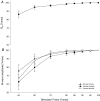Severity of arterial hypoxaemia affects the relative contributions of peripheral muscle fatigue to exercise performance in healthy humans
- PMID: 17317739
- PMCID: PMC2075206
- DOI: 10.1113/jphysiol.2007.129700
Severity of arterial hypoxaemia affects the relative contributions of peripheral muscle fatigue to exercise performance in healthy humans
Abstract
We examined the effects of hypoxia severity on peripheral versus central determinants of exercise performance. Eight cyclists performed constant-load exercise to exhaustion at various fractions of inspired O2 fraction (FIO2 0.21/0.15/0.10). At task failure (pedal frequency < 70% target) arterial hypoxaemia was surreptitiously reversed via acute O2 supplementation (FIO2 = 0.30) and subjects were encouraged to continue exercising. Peripheral fatigue was assessed via changes in potentiated quadriceps twitch force (DeltaQ(tw,pot)) as measured pre- versus post-exercise in response to supramaximal femoral nerve stimulation. At task failure in normoxia (haemoglobin saturation (SpO2) approximately 94%, 656 +/- 82 s) and moderate hypoxia (SpO2) approximately 82%, 278 +/- 16 s), hyperoxygenation had no significant effect on prolonging endurance time. However, following task failure in severe hypoxia (SpO2) approximately 67%; 125 +/- 6 s), hyperoxygenation elicited a significant prolongation of time to exhaustion (171 +/- 61%). The magnitude of DeltaQ(tw,pot) at exhaustion was not different among the three trials (-35% to -36%, P = 0.8). Furthermore, quadriceps integrated EMG, blood lactate, heart rate, and effort perceptions all rose significantly throughout exercise, and to a similar extent at exhaustion following hyperoxygenation at all levels of arterial oxygenation. Since hyperoxygenation prolonged exercise time only in severe hypoxia, we repeated this trial and assessed peripheral fatigue following task failure prior to hyperoxygenation (125 +/- 6 s). Although Q(tw,pot) was reduced from pre-exercise baseline (-23%; P < 0.01), peripheral fatigue was substantially less (P < 0.01) than that observed at task failure in normoxia and moderate hypoxia. We conclude that across the range of normoxia to severe hypoxia, the major determinants of central motor output and exercise performance switches from a predominantly peripheral origin of fatigue to a hypoxia-sensitive central component of fatigue, probably involving brain hypoxic effects on effort perception.
Figures






Comment in
-
Arterial oxygenation, central motor output and exercise performance in humans.J Physiol. 2007 Dec 15;585(Pt 3):919-21; author reply 923-4. doi: 10.1113/jphysiol.2007.145110. Epub 2007 Oct 25. J Physiol. 2007. PMID: 17962324 Free PMC article. No abstract available.
References
-
- Alexander JK, Hartley LH, Modelski M, Grover RF. Reduction of stroke volume during exercise in man following ascent to 3100 m altitude. J Appl Physiol. 1967;23:849–858. - PubMed
-
- Amann M, Romer LM, Pegelow DF, Jacques AJ, Hess CJ, Dempsey JA. Effects of arterial oxygen content on peripheral locomotor muscle fatigue. J Appl Physiol. 2006b;101:119–127. - PubMed
-
- Amann M, Subudhi A, Foster C. Influence of testing protocol on ventilatory thresholds and cycling performance. Med Sci Sports Exerc. 2004;36:613–622. - PubMed
-
- Bigland-Ritchie B, Vollestad N. Hypoxia and Fatigue. How are they Related? Indianapolis IL USA: Benchmark; 1988.
Publication types
MeSH terms
Substances
Grants and funding
LinkOut - more resources
Full Text Sources
Medical

